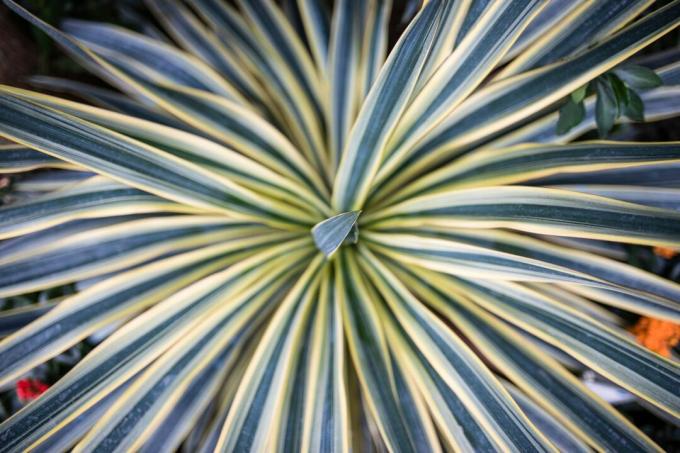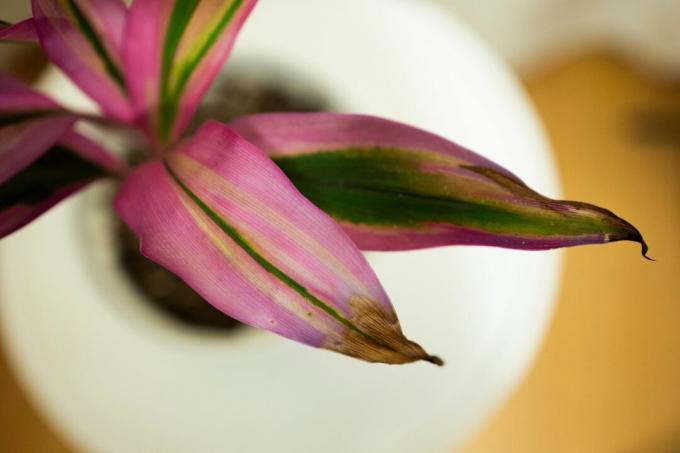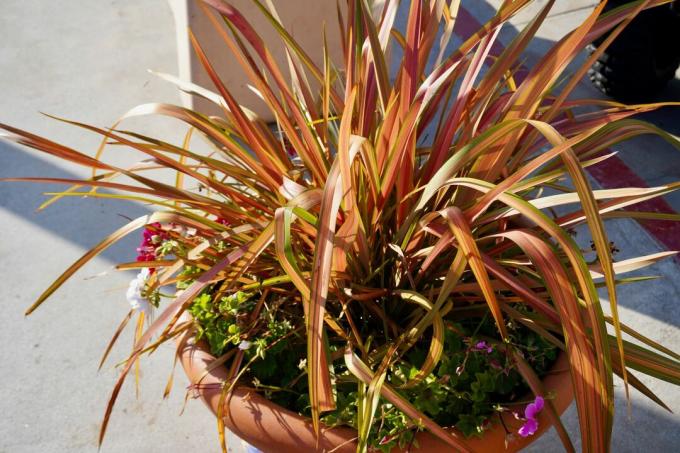Club lilies are exotic houseplants that need a few care tips to ensure they develop magnificently - species-appropriate overwintering is particularly important.

The club lily (Cordyline) can be found in various species and varieties as an ornamental plant. The various leaf colors ensure an exotic flair in your home. In this article, we show which species need to be overwintered and cared for, so that you can enjoy them for a long time.
contents
- Club lily: origin and properties
-
The most beautiful species of club lilies
- Cordyline australis
- Cordyline fruticosa
- Plants: Location as a houseplant and in the garden
-
Care of the club lily: cutting and Co.
- Cut, water and fertilize
- Brown leaves on the club lily: what to do?
- Is the club lily hardy?
- Propagating Club Lily
- Is the club lily poisonous?
Club lily: origin and properties
Club lilies are native to the tropical forests of Australia and New Zealand. In this country, they are popular potted plants that add a touch of the exotic. They belong to the asparagus family and are related to the
dragon tree (dracaena), which they also slightly resemble in appearance. Because cordylines look like palm trees: Sword-shaped leaves form at the end of the thin trunk. The leaves are green, red or patterned depending on the species.How big do club lilies get?
Cordyline grow to about 150-250 cm in pots. This growth height is reached only slowly. In midsummer, older trumpet lilies in particular bloom white and have long panicles. If the flowers have dried up, the shoot divides at this point.

The most beautiful species of club lilies
There are many varieties of club lilies. With us as indoor plants are the two types Cordyline australis and Cordyline fruticosa spread.
Cordyline australis
This species is characterized by its 70 - 90 cm long, up to 5 cm wide sword-shaped leaves without a stem. It is a cold-tolerant species and should be in a partially shaded location at around 15 - 20 °C. It can also be brought outside from May, but should be brought back inside from September. Color and pattern vary between varieties.
- ‘Red Star’: This red club lily is one of the best-selling varieties. Their leaves are bronze to reddish.

- ‘Torbay Dazzler’: This variety is characterized by its green leaves with cream-colored edges. The underside of the leaf shows a reddish colored leaf vein.

Cordyline fruticosa
In this species, the leaves are up to 50 cm long, lanceolate and usually with a stalk. the Cordyline fruticosa is a warmth-loving mace lily and should be bright and at temperatures between 18 - 22 °C. The species can be in the garden from June to August. The variation of leaf color and pattern is versatile.
- ‘Glauca’: The leaves of this variety are rather elongated and bright green in color. Young leaves can appear slightly reddish.
- 'Kiwi': A yellow stripe pattern can be seen on the green leaves. In addition, a red border adorns the leaves. The plants should be in a light position to preserve the color.

- 'Mambo': The reddish color is surrounded by a pink border. Young leaves are bronze in colour. A bright location should be chosen to preserve the reddish colour.
- 'Tango': This variety is characterized by the irregular green-pink variegation of the leaves. To increase the pink proportion of the leaves, the plants should be light.

Plants: Location as a houseplant and in the garden
In our latitudes, club lilies are indoor plants because they are not frost-free. In the semi-shade and with sufficient humidity, they can also find a place on the terrace, the balcony or in the garden in summer.
But first they should be repotted after purchase. The substrate must be loose to prevent waterlogging. Here, for example, ours is suitable Plantura organic potting soil. It consists of 100% natural raw materials and is also peat-free. There is some expanded clay in this soil, so the soil stays loose longer. Since club lilies need a very draining substrate, a further addition of 20% expanded clay is recommended. A drainage layer on the bottom of the pot also proves useful.
Due to the slow growth of the club lily, annual repotting is not necessary. If a high-quality soil was used, it is sufficient to put it in fresh substrate every two to three years. However, it does not necessarily need a larger pot: this should only be chosen if the roots are already touching the edges of the pot.
Which location to choose for club lilies?
Both the Cordyline australis as well as the Cordyline fruticosa should stand in a bright to semi-shady location without direct sun if possible. Variegated varieties in particular like a bright spot so that the color of the leaves is preserved.
The air should not be too dry, otherwise brown leaf tips can easily occur. Spraying the leaves with lime-free water every week can help here. A bowl of water and expanded clay balls under the pot can also prevent a lack of humidity. Especially in winter, the humidity in rooms is very low due to dry heating air. A bright bathroom is a good location for tiger lilies because of the high humidity.

The room temperature should not be too warm. Cordyline australis tolerates somewhat colder temperatures between 15 - 20 °C. Cordyline fruticosa should be in a room with 18 – 22 °C. Permanent damage can occur with this species at temperatures below 18 °C for a long period of time.
Can club lilies be in the garden?
Club lilies can be kept in pots in the garden, on the terrace or on the balcony in summer, primarily from June to August. A wind-protected, half-shady location is important. In a place in direct sun, you should pay attention to an increased watering to compensate for the transpiration of the leaves. Both club lily species should move back into the house or apartment in autumn. the Cordyline australis needs a cool place to hibernate to protect it from pests. An unheated but frost-free greenhouse is suitable for this, for example.

Care of the club lily: cutting and Co.
The care of the club lily is not complicated, it is a frugal plant. Nevertheless, certain points must be observed:
Cut, water and fertilize
Pruning a club lily is not strictly necessary. If you prefer a bushy, dense growth, pruning can help. Even if the plant is out of shape, cutting off shoots is recommended. Because the club lily will sprout again at the cutting edge. The cut off part can be used as a cutting for propagation. A cut may also be necessary if the club lily is too large.

There are several tips to keep in mind when watering. Club lilies like a moist root ball. It should never dry out completely. However, waterlogging must also be avoided to prevent root rot. In addition, club lilies tolerate low-lime water best. For example, rainwater or stagnant tap water are very suitable. In autumn, at the end of the vegetation period, club lilies should only be watered moderately, with the root ball still moist.
Since club lilies stop growing in winter, the last nutrient application should be in October. At the beginning of the growing season in March, weekly fertilization should start again. This ensures healthy and vigorous growth of the club lilies. For example, our is suitable for this Plantura organic indoor and green plant fertilizer, with which the plants are optimally supplied with the right nutrient ratio. It can simply be administered with the irrigation water.
Tip: Thrips infestation should be monitored all year round. It is also important to check the club lilies for spider mites, especially in winter. As Identify and fight spider mites, read our special article.
Brown leaves on the club lily: what to do?
If only the oldest leaves on the club lily are turning brown and shed, that is not a cause for concern at first. It is a natural process that creates the palm-shaped crown. However, if more brown or yellow leaves can be seen on the club lilies, this can have several causes:
nutrient deficiency: Leaves that turn yellow and then fall off can indicate a lack of nutrients. The weekly fertilization of the club lily is to be included.
air dryness: If the humidity is too low, the tips of the leaves in particular will quickly turn brown. Spraying lime-free water on the leaves weekly ensures adequate moisture.
root rot: Too much standing water in the root ball causes the root system to rot. This leads to discoloration of the leaves with subsequent leaf loss. The rotten roots must be removed as soon as possible and the root ball should be allowed to dry. In this respect, it is not allowed to continue pouring for the time being. Once the root ball has dried, watering should be slowly resumed. However, the amount of water should always be reduced in order to prevent the remaining roots from rotting again.

Is the club lily hardy?
Club lilies are not hardy, they are particularly sensitive to frost. Therefore, club lilies should find a place in the house or apartment for the winter. A cool ambient temperature of about 5 - 10 °C should be ensured. A bright location is recommended and overwintering is also possible in the conservatory or frost-free greenhouse. A cool place usually prevents infestation with pests.

Propagating Club Lily
Cuttings are recommended for propagating the club lilies. These should be cut in the summer months to ensure the best possible chance of successful rooting.
Head cuttings are possible, i.e. section of the shoot tips. The cutting may have one leaf, additional leaves should be removed. Stick it in a 1:1 mixture of sand and soil. The substrate should be loose and have a reduced nutrient content adapted to cuttings. This is the case with our Plantura, for example Organic herbal & seed soil given. In addition, it consists of 100% natural raw materials and is peat-free. If the soil is kept moist, the cuttings will root at 18 - 21 ° within about eight to twelve weeks. It is also possible to root the club lily head cuttings in a glass of water. The rooted club lily can be placed in the desired pot and placed in a suitable location.
Stem cuttings often have no leaves. They are cut further down the club lily and should have at least two leaf nodes. Root formation is stimulated by two longitudinal cuts that are placed directly on the sand-soil mixture. The shoot cutting lying on the growing substrate is kept moist and develops roots and leaves within two to three months.
Is the club lily poisonous?
The club lily is non-toxic to humans and cats, but the saponins it contains are slightly toxic to dogs. An additional danger for children and animals are the sharp-edged blades, which can easily lead to injuries in the mouth. A certain degree of caution is therefore required when choosing the location.

In addition to the club lily, there are others exotic houseplantsthat create a special atmosphere in your home.



